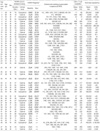1. Palella FJ Jr, Delaney KM, Moorman AC, Loveless MO, Fuhrer J, Satten GA, Aschman DJ, Holmberg SD. Declining morbidity and mortality among patients with advanced human immunodeficiency virus infection. HIV Outpatient Study Investigators. N Engl J Med. 1998. 338:853–860.
2. Bangsberg DR, Hecht FM, Clague H, Charlebois ED, Ciccarone D, Chesney M, Moss A. Provider assessment of adherence to HIV antiretroviral therapy. J Acquir Immune Defic Syndr. 2001. 26:435–442.

3. Durant J, Clevenbergh P, Halfon P, Delgiudice P, Porsin S, Simonet P, Montagne N, Boucher CA, Schapiro JM, Dellamonica P. Drug-resistance genotyping in HIV-1 therapy: the VIRADAPT randomised controlled trial. Lancet. 1999. 353:2195–2199.
4. Cohen CJ, Hunt S, Sension M, Farthing C, Conant M, Jacobson S, Nadler J, Verbiest W, Hertogs K, Ames M, Rinehart AR, Graham NM. A randomized trial assessing the impact of phenotypic resistance testing on antiretroviral therapy. AIDS. 2002. 16:579–588.

5. Cingolani A, Antinori A, Rizzo MG, Murri R, Ammassari A, Baldini F, Di Giambenedetto S, Cauda R, De Luca A. Usefulness of monitoring HIV drug resistance and adherence in individuals failing highly active antiretroviral therapy: a randomized study (ARGENTA). AIDS. 2002. 16:369–379.

6. del Rio C. Current concepts in antiretroviral therapy failure. Top HIV Med. 2006. 14:102–106.
7. Tural C, Ruiz L, Holtzer C, Schapiro J, Viciana P, Gonzalez J, Domingo P, Boucher C, Rey-Joly C, Clotet B. Clinical utility of HIV-1 genotyping and expert advice: the Havana trial. AIDS. 2002. 16:209–218.

8. Van Laethem K, Vandamme AM. Interpreting resistance data for HIV-1 therapy management--know the limitations. AIDS Rev. 2006. 8:37–43.
9. Vray M, Meynard JL, Dalban C, Morand-Joubert L, Clavel F, Brun-Vezinet F, Peytavin G, Costagliola D, Girard PM. Predictors of the virological response to a change in the antiretroviral treatment regimen in HIV-1-infected patients enrolled in a randomized trial comparing genotyping, phenotyping and standard of care (Narval trial, ANRS 088). Antivir Ther. 2003. 8:427–434.
10. Kim SR, Rheu EK, Seol YM, Cha DH, Lee SJ, Yoon YK, Park SM, Kim HH, Rheu HS, Ahn SC, Lee SH, Kwak IS, Cho GJ. Antiretroviral drug resistance among drug-naive HIV-1 infected patients. Korean J Med. 2007. 73:243–250.
11. Sung H, Jung YS, Kang MW, Bae IG, Chang HH, Woo JH, Cho YK. High frequency of drug resistance mutations in human immunodeficiency virus type 1-infected Korean patients treated with HAART. AIDS Res Hum Retroviruses. 2007. 23:1223–1229.

12. Choi H, Jeong SJ, Lee HS, Chin BS, Choi SH, Han SH, Kim MS, Kim CO, Choi JY, Song YG, Kim JM. Two cases of multidrug-resistant human immunodeficiency virus infection treated with atazanavir and lopinavir/ritonavir combination therapy. J Korean Med Sci. 2008. 23:737–739.

13. National Institutes of Health (U.S.). Guidelines for the Use of Antiretroviral Agents in HIV-1-Infected Adults and Adolescents. 2007. Bethesda, ME: U.S. DHHS Panel on Antiretroviral Guidelines for Adults and Adolescents.
14. De Luca A, Cingolani A, Di Giambenedetto S, Trotta MP, Baldini F, Rizzo MG, Bertoli A, Liuzzi G, Narciso P, Murri R, Ammassari A, Perno CF, Antinori A. Variable prediction of antiretroviral treatment outcome by different systems for interpreting genotypic human immunodeficiency virus type 1 drug resistance. J Infect Dis. 2003. 187:1934–1943.

15. Kuritzkes DR, Quinn JB, Benoit SL, Shugarts DL, Griffin A, Bakhtiari M, Poticha D, Eron JJ, Fallon MA, Rubin M. Drug resistance and virologic response in NUCA 3001, a randomized trial of lamivudine (3TC) versus zidovudine (ZDV) versus ZDV plus 3TC in previously untreated patients. AIDS. 1996. 10:975–981.

16. Maguire M, Gartland M, Moore S, Hill A, Tisdale M, Harrigan R, Kleim JP. Absence of zidovudine resistance in antiretroviral-naive patients following zidovudine/lamivudine/protease inhibitor combination therapy: virological evaluation of the AVANTI 2 and AVANTI 3 studies. AIDS. 2000. 14:1195–1201.

17. Choi JY, Park YS, Kim CO, Park YS, Yoon HJ, Shin SY, Kim YA, Song YG, Kim JM. Correlation between adherence to antiretroviral treatment and virologic failure in HIV-infected Koreans. Infect Chemother. 2005. 37:9–15.
18. Kim MS, Shin SY, Park YS, Kim YA, Ku NS, Kim JH, Kim YK, Choi JY, Song YG, Kim JM. Therapeutic response of HAART and analysis of related factors in Korean HIV-infected persons. Infect Chemother. 2007. 39:142–150.







 PDF
PDF ePub
ePub Citation
Citation Print
Print


 XML Download
XML Download